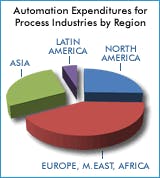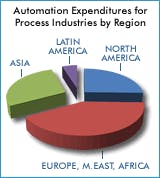Also, shipments for many new project orders received during 2010 were delayed until 2011. ARC expects the tepid growth seen during 2010 to accelerate in 2011, but remains skeptical about the process automation market reaching pre-recession growth levels. Historically, the process automation market has been characterized by slow yet steady growth, and ARC says it expects the market will return to this pattern with an overall CAGR (compound annual growth rate) of roughly 6 percent over the five-year period of 2009-2014. Suppliers with quick access to raw materials and components and an efficient supply chain to enable quick ramp-up of production and inventory will be in the best position to participate in the increase in demand, notes ARC.
Purchasing managers’ indexes (PMIs) provide a good barometer of overall health in the manufacturing and automation markets. PMIs typically include data, such as production level, new orders, supplier deliveries, inventories, and employment level. A PMI reading below 50 indicates a general contraction in the manufacturing economy being measured while any reading over 50 indicates expansion. The J.P. Morgan global manufacturing PMI edged up to 57.8 from 57.1 in January, marking the second-fastest reading ever in the global gauge, which is based on other surveys covering over 7,500 purchasing managers in nearly 30 countries.
Output and new order components accelerated, and the input price gauge rose to 76.7 from 73.3 in January, according to ARC. The U.S. ISM represents 28.6 percent of the gauge, followed by Japan at 12.3 percent, China at 7.4 percent, Germany at 5 percent, and the UK at 4.2 percent.
Most automation suppliers followed a conservative strategy of cutting cost and inventories to match declining demand during the lengthy economic slowdown. Suppliers accustomed to taking risks should put themselves in a position to take advantage of growth opportunities that are taking root in developing countries. Sluggish demand has hurt the bottom lines of sub-suppliers, making them more open to negotiate on both prices and terms.
As the economy recovers, ARC says automation suppliers must make plans to make the necessary changes and emerge as stronger organizations that are able to meet renewed demand. However, this confidence will only come if there is a clear understanding in their organizations about the long-term trends that drive demand for automation and develop strategies to satisfy those demands.
Some of these long-term trends include:
• Emerging markets will need to expand their power grids for years to come
• Mature economies in North America and Europe will have to renew their aging infrastructures
• Energy efficiency initiatives will be implemented across all areas of industrial organizations
• Industry must efficiently comply with regulatory agencies without losing productivity
• Most countries must tackle climate change before the emissions from the growing use of fossil fuels stifles progress, an issue that is plaguing China
• The intense competition of global markets will continue to drive industry to become more efficient
• Many of the easy gains have already been realized by industry, so now they will look for new ways to raise productivity
• Organizations will require even more information to make optimized business decisions
• Sustainability will be part of all discussions and implementations
• EH&S requirements will drive new automation investments beyond productivity improvements
• Discovery and production of new energy sources, such as shale gas, geothermal, and clean coal



